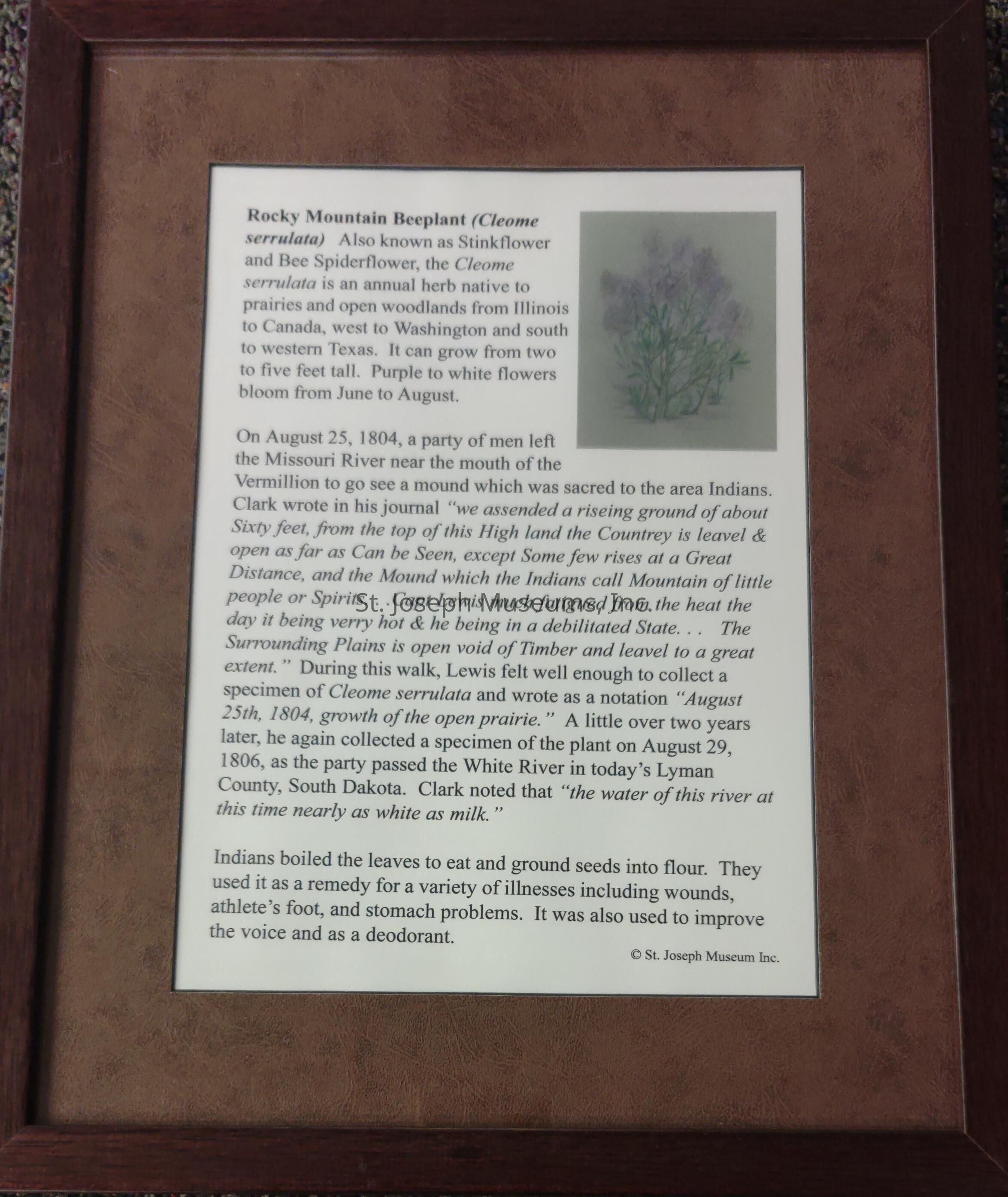Name/Title
Rocky Mountain Beeplant (Cleome serrulata)Entry/Object ID
2021.1.27 BScope and Content
Rocky Mountain Beeplant (Cleome serrulata) plant description, framed.
Also known as Stinkflower and Bee Spiderflower, the Cleome serrulata is an annual herb native to prairies and open woodlands from Illinois to Canada, west to Washington and south to western Texas. It can grow from two to five feet tall. Purple to white flowers bloom from June to August.
On August 25,1804, a party of men left the Missouri River near the mouth of the Vermillion to go see a mound which was sacred to the area Indians. Clark wrote in his journal "we assended a riseing ground of about Sixty feet, from the top of this High land the Countrey is leavel & open as far as Can be Seen, except Some few rises at a Great Distance, and the Mound which the Indians call Mountain of little people or Spirits...Capt Lewis much fatigued from the heat the day it being verry hot & he being in a debilitated State...The Surrounding Plains is open void of Timber and leavel to a great extent." During this walk, Lewis felt well enough to collect a specimen of Cleome serrulata and wrote as a notation "August 25th, 1804, growth of the open prairie." A little over two years later, he again collected a specimen of the plant on August 29, 1806 as the party passed the White River in today's Lyman County, South Dakota. Clark noted that "the water of this river at this time nearly as white as milk."
Indians boiled the leaves to eat and ground seeds into flour. They used it as a remedy for a variety of illnesses including wounds, athlete's foot, and stomach problems. It was also used to improve the voice and as a deodorant.Context
Originally designed by the St. Joseph Museum in the fall of 2004. Titled "Botanical Wonders of the Uncharted West. The Recorded Flora of the Lewis & Clark Expedition."Collection
Lewis and ClarkLexicon
LOC Thesaurus for Graphic Materials
Botanical drawings, Expeditions & surveysArchive Items Details
Title
Rocky Mountain Beeplant (Cleome serrulata)Creator
Mary L. FletcherDate(s) of Creation
2004Subjects
Plants, Watercolor paintingsParts
Count
2Parts
Watercolor of plant and descriptive label, both framed.Condition
Overall Condition
Very GoodProvenance
Notes
"Botanical Wonders of the Uncharted West" visually depicts how well Lewis followed Jefferson's instructions. In recognition of this achievement, The S. Joseph Museums, Inc. commissioned accomplished artist Mary Fletcher to create fifty (50) selected paintings of flora documented by the Corps during their Journey. These framed watercolor originals are accompanied by similarly framed labels, generated by former Head of Research Jackie Lewin, which describe the corresponding plants with appropriate quotations from the Journals. This collection makes available for study and appreciation plants that were new to Lewis and Clark, but which Native Peoples already recognized as valuable sources of food, medicine, and tools. Some of these still remain a mystery to many, but all will enjoy their beauty, their diverse uses, and their accomplished renderings.
